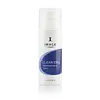What's inside
What's inside
 Key Ingredients
Key Ingredients

 Benefits
Benefits

 Concerns
Concerns

 Ingredients Side-by-side
Ingredients Side-by-side

Benzoyl Peroxide 5%
Water
Skin ConditioningCaprylic/Capric Triglyceride
MaskingOligopeptide-10
AntimicrobialCetearyl Olivate
Syringa Vulgaris Extract
Skin ConditioningChamomilla Recutita Flower Extract
MaskingOryza Sativa Bran Extract
Skin ConditioningSorbitan Olivate
EmulsifyingAloe Barbadensis Leaf Extract
EmollientStearic Acid
CleansingSucrose Cocoate
EmulsifyingTocopheryl Acetate
AntioxidantMaltodextrin
AbsorbentMelaleuca Alternifolia Leaf Oil
AntioxidantMentha Viridis Leaf Oil
AstringentDisodium EDTA
Eucalyptus Globulus Leaf Oil
PerfumingArnica Montana Flower Extract
MaskingAesculus Hippocastanum Extract
AntioxidantMelia Azadirachta Leaf Extract
Skin ConditioningBoswellia Serrata Extract
Skin ConditioningHoney Extract
HumectantCamellia Sinensis Leaf Extract
AntimicrobialPotassium Sorbate
PreservativeSodium Benzoate
MaskingButylene Glycol
HumectantPhenoxyethanol
PreservativeCaprylyl Glycol
EmollientHexylene Glycol
EmulsifyingBenzoyl Peroxide 5%, Water, Caprylic/Capric Triglyceride, Oligopeptide-10, Cetearyl Olivate, Syringa Vulgaris Extract, Chamomilla Recutita Flower Extract, Oryza Sativa Bran Extract, Sorbitan Olivate, Aloe Barbadensis Leaf Extract, Stearic Acid, Sucrose Cocoate, Tocopheryl Acetate, Maltodextrin, Melaleuca Alternifolia Leaf Oil, Mentha Viridis Leaf Oil, Disodium EDTA, Eucalyptus Globulus Leaf Oil, Arnica Montana Flower Extract, Aesculus Hippocastanum Extract, Melia Azadirachta Leaf Extract, Boswellia Serrata Extract, Honey Extract, Camellia Sinensis Leaf Extract, Potassium Sorbate, Sodium Benzoate, Butylene Glycol, Phenoxyethanol, Caprylyl Glycol, Hexylene Glycol
Salicylic Acid 2%
MaskingWater
Skin ConditioningDimethicone
EmollientPropanediol
SolventCaprylic/Capric Triglyceride
MaskingGlycerin
HumectantJojoba Esters
EmollientIsodecyl Neopentanoate
EmollientCetearyl Alcohol
EmollientPanthenol
Skin ConditioningPolysilicone-11
Cordyceps Sinensis Extract
AntioxidantTrametes Versicolor Extract
Helianthus Annuus Seed Wax
Skin ConditioningSodium Hydroxide
BufferingHydroxyethyl Acrylate/Sodium Acryloyldimethyl Taurate Copolymer
Emulsion StabilisingPolyacrylate Crosspolymer-6
Emulsion StabilisingCeteareth-20
CleansingIsohexadecane
EmollientTocopheryl Acetate
AntioxidantHydrogenated Lecithin
EmulsifyingAloe Barbadensis Leaf Juice
Skin ConditioningButylene Glycol
HumectantAllantoin
Skin ConditioningDisodium EDTA
Sodium Hyaluronate
HumectantAcacia Decurrens Flower Wax
EmollientPolyglycerin-3
HumectantPhenoxyethanol
PreservativePolysorbate 60
EmulsifyingSodium PCA
HumectantSodium Citrate
BufferingSorbitan Isostearate
EmulsifyingMaclura Cochinchinensis Leaf Prenylflavonoids
T-Butyl Alcohol
PerfumingGlycosaminoglycans
EmollientPotassium Sorbate
PreservativeSodium Benzoate
MaskingEthylhexylglycerin
Skin ConditioningCitric Acid
BufferingTrisodium EDTA
Salicylic Acid 2%, Water, Dimethicone, Propanediol, Caprylic/Capric Triglyceride, Glycerin, Jojoba Esters, Isodecyl Neopentanoate, Cetearyl Alcohol, Panthenol, Polysilicone-11, Cordyceps Sinensis Extract, Trametes Versicolor Extract, Helianthus Annuus Seed Wax, Sodium Hydroxide, Hydroxyethyl Acrylate/Sodium Acryloyldimethyl Taurate Copolymer, Polyacrylate Crosspolymer-6, Ceteareth-20, Isohexadecane, Tocopheryl Acetate, Hydrogenated Lecithin, Aloe Barbadensis Leaf Juice, Butylene Glycol, Allantoin, Disodium EDTA, Sodium Hyaluronate, Acacia Decurrens Flower Wax, Polyglycerin-3, Phenoxyethanol, Polysorbate 60, Sodium PCA, Sodium Citrate, Sorbitan Isostearate, Maclura Cochinchinensis Leaf Prenylflavonoids, T-Butyl Alcohol, Glycosaminoglycans, Potassium Sorbate, Sodium Benzoate, Ethylhexylglycerin, Citric Acid, Trisodium EDTA
Alternatives
Ingredients Explained
These ingredients are found in both products.
Ingredients higher up in an ingredient list are typically present in a larger amount.
Butylene Glycol (or BG) is used within cosmetic products for a few different reasons:
Overall, Butylene Glycol is a safe and well-rounded ingredient that works well with other ingredients.
Though this ingredient works well with most skin types, some people with sensitive skin may experience a reaction such as allergic rashes, closed comedones, or itchiness.
Learn more about Butylene GlycolThis ingredient is an emollient, solvent, and texture enhancer. It is considered a skin-softener by helping the skin prevent moisture loss.
It helps thicken a product's formula and makes it easier to spread by dissolving clumping compounds.
Caprylic Triglyceride is made by combining glycerin with coconut oil, forming a clear liquid.
While there is an assumption Caprylic Triglyceride can clog pores due to it being derived from coconut oil, there is no research supporting this.
Learn more about Caprylic/Capric TriglycerideDisodium EDTA plays a role in making products more stable by aiding other preservatives.
It is a chelating agent, meaning it neutralizes metal ions that may be found in a product.
Disodium EDTA is a salt of edetic acid and is found to be safe in cosmetic ingredients.
Learn more about Disodium EDTAPhenoxyethanol is a preservative that has germicide, antimicrobial, and aromatic properties. Studies show that phenoxyethanol can prevent microbial growth. By itself, it has a scent that is similar to that of a rose.
It's often used in formulations along with Caprylyl Glycol to preserve the shelf life of products.
Potassium Sorbate is a preservative used to prevent yeast and mold in products. It is commonly found in both cosmetic and food products.
This ingredient comes from potassium salt derived from sorbic acid. Sorbic acid is a natural antibiotic and effective against fungus.
Both potassium sorbate and sorbic acid can be found in baked goods, cheeses, dried meats, dried fruit, ice cream, pickles, wine, yogurt, and more.
You'll often find this ingredient used with other preservatives.
Learn more about Potassium SorbateSodium Benzoate is a preservative. It's used in both cosmetic and food products to inhibit the growth of mold and bacteria. It is typically produced synthetically.
Both the US FDA and EU Health Committee have approved the use of sodium benzoate. In the US, levels of 0.1% (of the total product) are allowed.
Sodium benzoate works as a preservative by inhibiting the growth of bacteria inside of cells. It prevents the cell from fermenting a type of sugar using an enzyme called phosphofructokinase.
It is the salt of benzoic acid. Foods containing sodium benzoate include soda, salad dressings, condiments, fruit juices, wines, and snack foods.
Studies for using ascorbic acid and sodium benzoate in cosmetics are lacking, especially in skincare routines with multiple steps.
We always recommend speaking with a professional, such as a dermatologist, if you have any concerns.
Learn more about Sodium BenzoateTocopheryl Acetate is AKA Vitamin E. It is an antioxidant and protects your skin from free radicals. Free radicals damage the skin by breaking down collagen.
One study found using Tocopheryl Acetate with Vitamin C decreased the number of sunburned cells.
Tocopheryl Acetate is commonly found in both skincare and dietary supplements.
Learn more about Tocopheryl AcetateWater. It's the most common cosmetic ingredient of all. You'll usually see it at the top of ingredient lists, meaning that it makes up the largest part of the product.
So why is it so popular? Water most often acts as a solvent - this means that it helps dissolve other ingredients into the formulation.
You'll also recognize water as that liquid we all need to stay alive. If you see this, drink a glass of water. Stay hydrated!
Learn more about Water